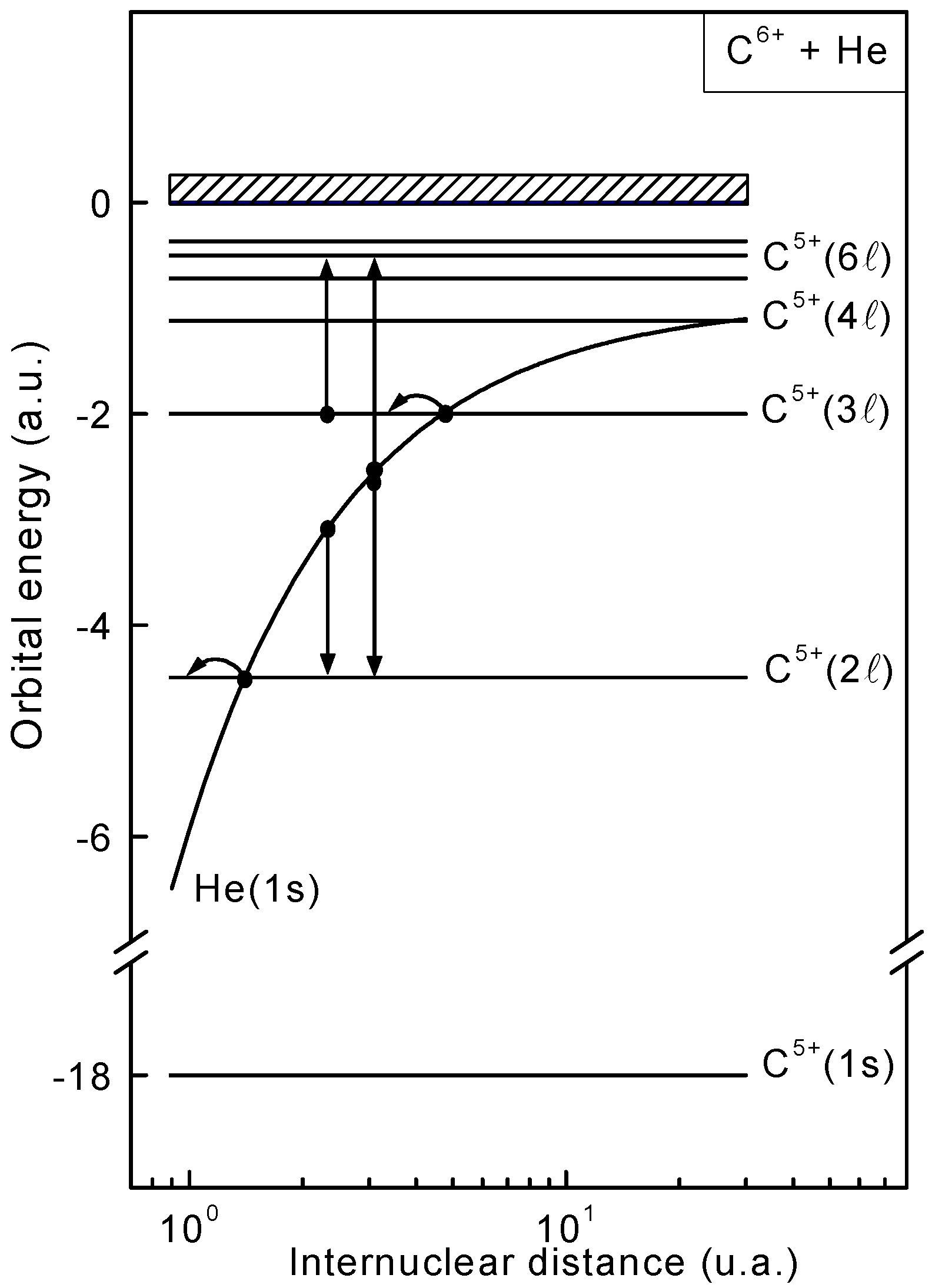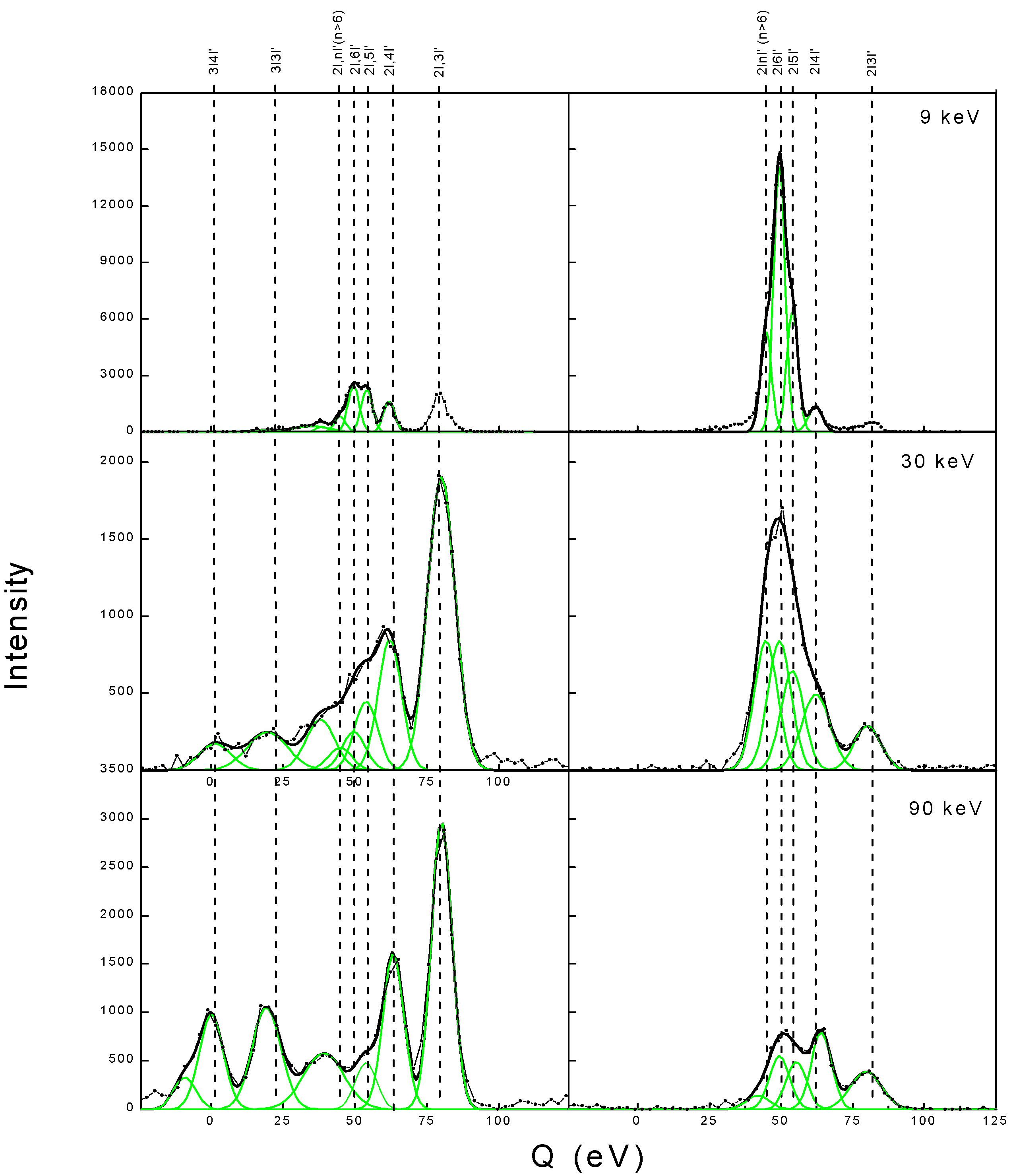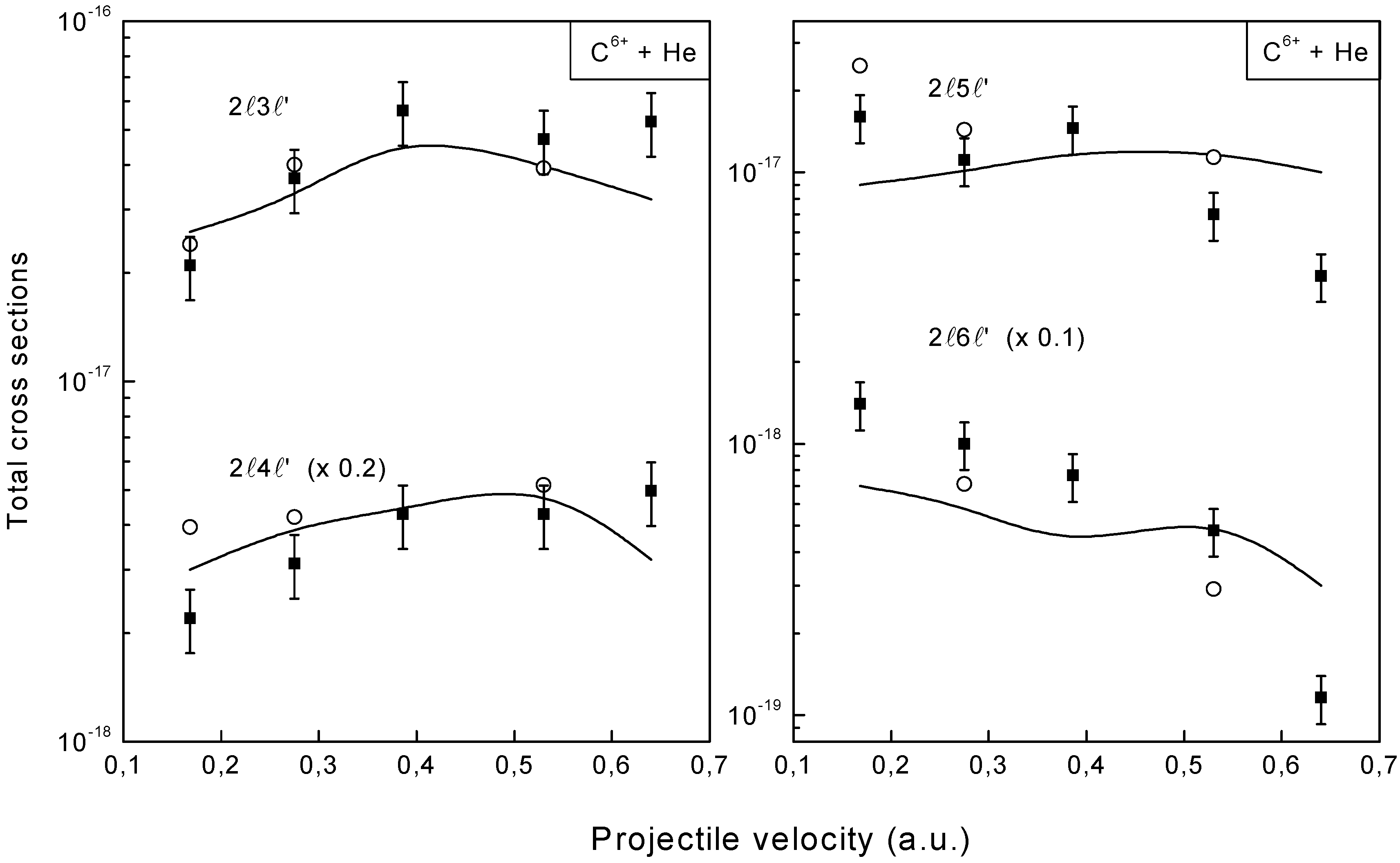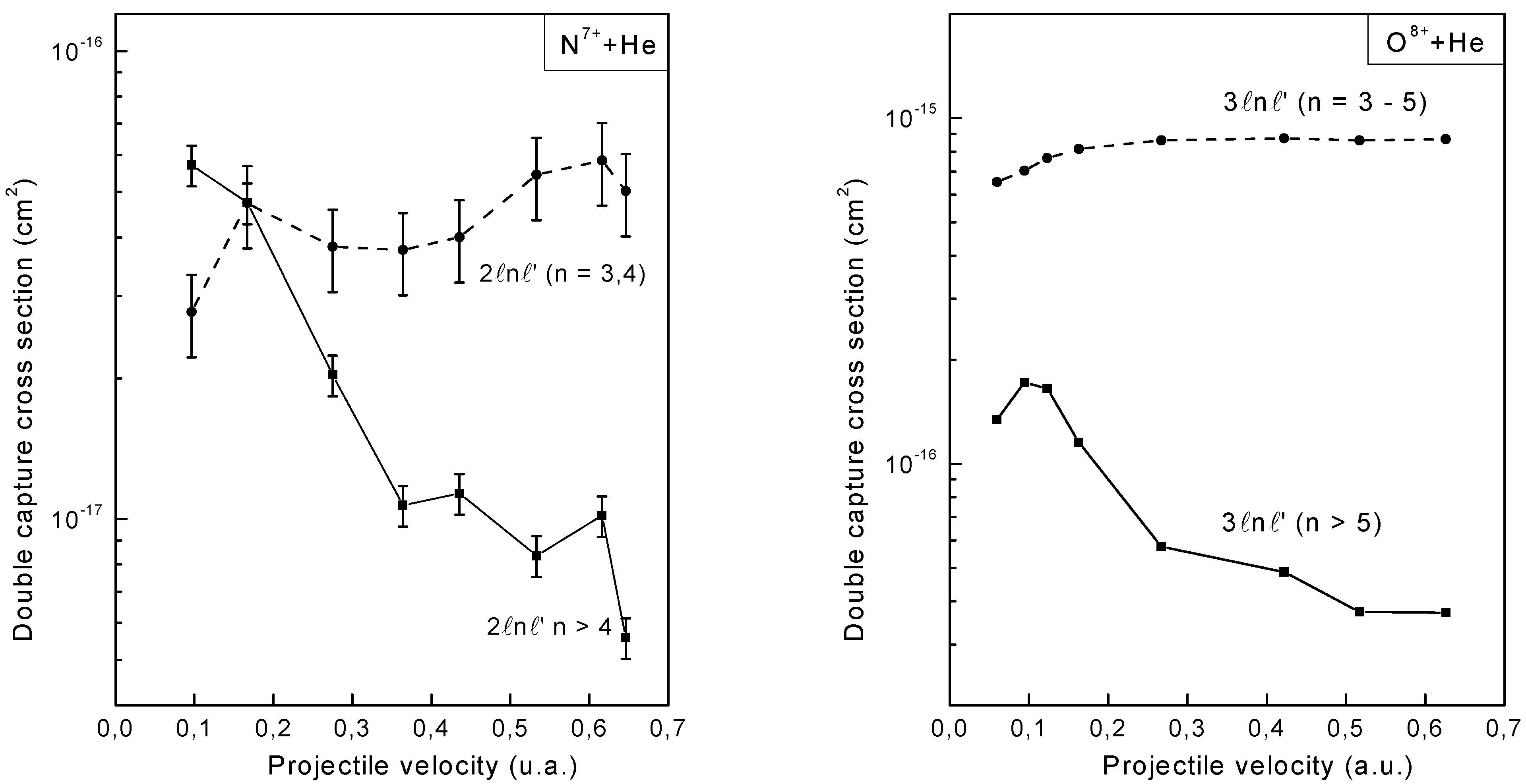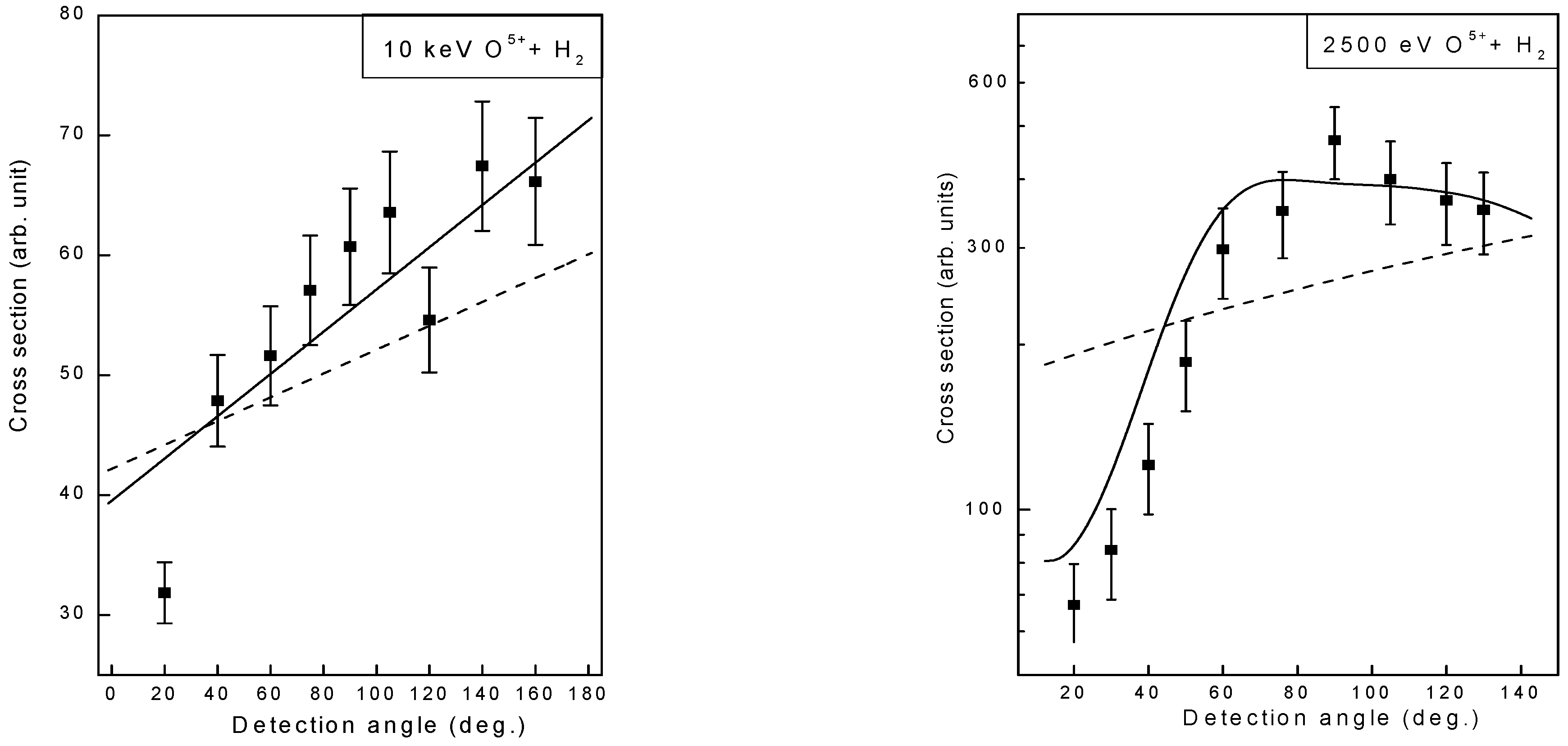Electron capture mechanisms
The mechanisms responsible for DEC are illustrated in
Figure 1 which shows approximate orbital energies for the system (C-He)
6+. In the incident channel, two electrons occupy the He 1
s orbital that crosses the 2λ and 3λ orbitals of C at internuclear distances of ~ 2 and 6 a.u., respectively. Hence, the DEC process may occur by two independent one-electron transitions (denoted
monoelectronic in the following), due to the nucleus electron interaction. Then, configurations of quasi equivalent electrons 2λ3λ’ and 3λ3λ’ are produced [
22,
23].
Figure 1.
Diagram of orbital energies for the system (C-He)6+.
Figure 1.
Diagram of orbital energies for the system (C-He)6+.
Furthermore, as shown in
Figure 1, resonance conditions are created at ~ 3 a.u. for a
dielectronic process referred to as correlated double capture (CDC) process, due to the electron-electron interaction. The CDC process produces configurations of non equivalent electron
nλ
n’λ
’ (
n’ >>
n), such as 2λ6λ’ in
Figure 1. It is pointed out that two independent one-electron transitions are unlikely to produce such configurations, since the probability to populate the 6λ orbital by a monoelectronic transition is negligible.
A correlated two-step mechanism may also lead to the production of the configurations 2λ6λ’. A first one-electron transition, populating the 3λ orbital of C, is followed by a correlated transfer excitation (CTE) process [
22], involving a two-electron transition, into 2λ6λ’. It is noted that both CDC and CTE processes, caused by the electron-electron interaction, are examples of the dielectronic processes of
autoexcitation.
Concerning the configurations of quasi equivalent electrons
nλ
n’λ
’ (
n ≈ n’), the situation is less clear, since they can be produced either by monoelectronic or by dielectronic processes [
11,
34]. For example, in the case of N
7+ + He collisions, the mechanisms responsible for the capture into 3λ3λ’ configurations depend onto the projectile velocity [
11]. At
vproj ~ 0.1 a.u., these configurations are populated by two independent one-electron transitions. At higher impact velocities, a direct transition between the entrance channel and the final state is necessary to explain such population. For the system C
6+ + He, it has been shown theoretically that the configurations of quasi equivalent electrons 2λ3λ’ and 2λ4λ’ are due to correlation effects [
35] in a projectile velocity range from 0.6 a.u. down to 0.1 a.u. All these examples suggest that no general consideration can be made for quasi equivalent electron configurations. Our attention will be concentrated on non equivalent electron configurations, since interesting general results are found.
Spectra analysis
Figure 2 shows typical
K-Auger spectra obtained at high resolution for the collision systems C
6+ + He (left side) and N
7+ + He (right side) [
37], at projectile energies in the range from 3.5 keV to 132 keV. The observation angle is 40
o with respect to the incident beam direction. The peaks are attributed to the configurations 2λnλ’ (n ≥ 3), which decay to the 2λελ’ continuum by means of Auger transitions. Auger electrons from the configurations 3λnλ’ (n ≥ 3) have been also observed in the present experiments. The associated peaks due to
M-Auger transitions are observed at electron energies lower than 80 eV.
Figure 2.
High-resolution spectra of K-Auger electrons produced in C6+ + He and N7+ + He collisions at a few projectile energies.
Figure 2.
High-resolution spectra of K-Auger electrons produced in C6+ + He and N7+ + He collisions at a few projectile energies.
Figure 2 indicates that, at the highest projectile energy, Auger electron emission originates primarily from quasi equivalent electron configurations 2λ3λ’ and 2λ4λ’. Configurations of non equivalent electrons are also visible but represent less than 10 % of the total intensity. In contrast, at lower projectile energies, the production of non equivalent electron configurations increases strongly. The increase of the population of such configurations is significant for C
6+ + He collisions. At collision energies lower than 10 keV, Auger intensities due to the configurations 2λ5λ’ and 2λ6λ’ is as large as that of the peaks originating from 2λ4λ’. Furthermore, configurations 2λnλ’ involving principal quantum numbers n as high as 9 are clearly visible.
For the system N7+ + He, the increase is also visible, but is less pronounced than that for the system C6+ + He. The configurations 2λnλ’, with n = 3 – 5 remain constant in the whole range of projectile energies. The intensity due to the configurations involving n ≥ 6 increases by a factor of ~ 10 when the projectile energy decreases from 70 keV to 3.5 keV.
Average Auger yields and double capture cross sections
For all the collision systems studied here, the Auger spectra were used to determine the corresponding cross sections. First, the Auger spectra were integrated to obtain single differential cross sections for Auger-electron emission attributed to a given configuration nλn’λ’. The total cross sections were then deduced by integration of over the electron-emission angle. To determine total double-capture cross sections , the quantity was divided by the corresponding average Auger yield ann’. This Auger-yield correction is due to the fact that configurations nλn’λ’ may also decay via radiative transitions which compete with the Auger transitions.
Auger yields integrated over λ and λ’ could be directly deduced from RIMS for the collisions C
6+ + He and Ne
10+ + He [
19,
33]. Double differential cross sections (DDCS) for autoionizing (ADC) and radiative (RDC) double capture were extracted from the experiment as a function of the energy gain
Q and the projectile scattering angle
θ. The DDCS were integrated over
θ. Results are shown in
Figure 3 for ADC and RDC following C
6+ + He collisions at projectile energies of 9, 30 and 90 keV. The results for
ann’ are reported in
Table 1. It is seen that the Auger yields are rather insensitive to the projectile energy, within the uncertainties. This finding is in different from previous conclusions, which were supported by experiments [
38]. In these experiments, the stabilization ration
R, defined by
R = 1 –
a, where
a is the Auger yield averaged on all the configurations, was presented for various systems. The authors found an increase of
R with decreasing the projectile velocity. As an explanation, they suggested that this can be due to an increase of
individual stabilization ratio
Rnn’ (i.e. 1 –
ann’) caused by a modification of the populated 2λnλ’ configurations in the electric field of the recoil ion leading to a shift to high-l values. [
38]. Rather, the increase of
R is due to the increase of cross sections for populating configurations of non equivalent electrons 2λnλ’ (n ≥ 4).
Table 1.
Experimental and theoretical Auger yield ann’ associate with the configurations 2λnλ’ of C4+.
Table 1.
Experimental and theoretical Auger yield ann’ associate with the configurations 2λnλ’ of C4+.
| | Configurations | Experiment [33] | Calculation [22] |
| | | 9 keV | 30 keV | 90 keV | 60 keV |
| | 2λ3λ’ | 0.77 ± 0.04 | 0.86 ± 0.02 | 0.81 ± 0.01 | 0.66 |
| | 2λ4λ’ | 0.49 ± 0.04 | 0.55 ± 0.06 | 0.63 ± 0.04 | 0.53 |
| | 2λ5λ’ | 0.26 ± 0.03 | 0.37 ± 0.12 | 0.44 ± 0.15 | 0.35 |
![Ijms 03 00115 i001]() | 2λ6λ’ | 0.15 ± 0.02 | 0.19 ± 0.11 | - | 0.29 |
| 2λ7λ’ | | | | 0.18 |
| 2λ8λ’ | 0.13 ± 0.04 | 0.11 ± 0.12 | - | 0.15 |
| 2λ9λ’ | | | | 0.11 |
Figure 3.
Experimental Q-value distributions for autoionizing (left side) and radiative (right side) DC in C6+ + He collisions.
Figure 3.
Experimental Q-value distributions for autoionizing (left side) and radiative (right side) DC in C6+ + He collisions.
The experimental Auger yields are also compared (right side of
Table 1) with theoretical calculations. The calculated Auger yields
ann’ were obtained by means of the Hartree-Fock code of Cowan [
39]. Since the quantity
ann’ depends strongly on the occupation probabilities associated with the quantum numbers λ and λ’, various distributions were tested [
40]. Moreover, calculations have been done considering the variation of these probabilities with respect to the collision energy. As a result, it was found that
ann’ are rather constant for all the collision energies, which is consistent with the experiment.
Double capture cross sections (DCCS)
for the system C6+ + He are shown in
Figure 4 as a function of the impact velocity. The quantity
deduced from Auger electron measurements is compared with the experimental cross sections extracted from RIMS [
33] and with theoretical calculations [
11,
15]. The framework of the theoretical method is the same as that described in Refs. [
35,
41]. In a straight-line impact-parameter treatment, the total electronic wave function is expanded onto a set of configurations built with product of one-electron diatomic-molecule (OEDM) orbitals, which are exact solutions of one-electronic two-center Hamiltonian. The introduction of this expansion in the Schrödinger equation leads to a set of coupled equations that is numerically integrated [
42]. First, a good overall agreement is seen for all the configurations. The experiments and the theory reproduce quite well the same variation of
with the projectile velocity. A noticeable disagreement is seen for the configurations 2λ6λ’ at the lowest velocities. This is partially due to the limitation of the theory which represents configurations such as 2λ6λ’ with only a few states [
19].
Figure 4.
Total cross sections for the production of the configurations 2λnλ’ (n =3 – 7) in C
6+ + He collisions. Experimental results are given by full squares [
37] and open circles [
33]. Solid lines show the theoretical results [
15]
Figure 4.
Total cross sections for the production of the configurations 2λnλ’ (n =3 – 7) in C
6+ + He collisions. Experimental results are given by full squares [
37] and open circles [
33]. Solid lines show the theoretical results [
15]
The variations of the cross sections with the projectile velocity were also analyzed in the case of N
7+ and O
8+ projectiles. The DCCS for populating the configurations 2λnλ’ and 3λnλ’ are presented in
Figure 5, for N
7+ + He (left side) and O
8+ + He (right side) collisions, respectively. While at high velocities the configurations of quasi equivalent electrons are mainly populated, the configurations of non equivalent electrons gain importance since the projectile velocity decreases. At the lowest velocities, they are found to be dominant in the case of N
7+ + He collisions.
The ratio
RNE between DCCS associated with non equivalent electron configurations and total DCCS is summarized in
Table 2 for both the lowest and highest velocitiesstudied here,
i.e. 0.01 a.u. and 0.6 a.u., respectively. The strong increase with decreasing the projectile velocity is confirmed for all the configurations, except for the series 3λnλ’ populated in N
7+ + He collisions. Note that the configurations 3λnλ’ (resp. 4λnλ’) for C
6+ + He (resp. Ne
10+ + He) collisions are not reported in
Table 2, since they are missing in our experiments.
Table 2.
Contribution of non equivalent electron configuration to total double electron capture.
Table 2.
Contribution of non equivalent electron configuration to total double electron capture.
| Projectile | Configuration | Ratio RNE |
| | | vproj ~ 0.6 a.u. | vproj ~ 0.01 a.u. |
| C6+ | 2λnλ’ (n ≥ 4) | 0.16 | 0.81 |
| N7+ | 2λnλ’ (n ≥ 4) | 0.10 | 0.68 |
| N7+ | 3λnλ’ (n ≥ 5) | 0.026 | 0.043 |
| O8+ | 3λnλ’ (n ≥ 5) | 0.04 | 0.17 |
| Ne10+ | 3λnλ’ (n ≥ 5) | 0.23 | 0.60 |
Figure 5.
DC cross section for populating configurations of quasi equivalent and non equivalent electrons for N7+ + He and O8+ + He collisions as a function of the projectile velocity.
Figure 5.
DC cross section for populating configurations of quasi equivalent and non equivalent electrons for N7+ + He and O8+ + He collisions as a function of the projectile velocity.
Figure 6.
Schematic diagram of potential energies for the systems AZ+ + He (Z = 6, 7, 8 and 10) in the case of the configurations 3λ6λ’ (solid curves) and 2λ6λ’ (dashed curve).
Figure 6.
Schematic diagram of potential energies for the systems AZ+ + He (Z = 6, 7, 8 and 10) in the case of the configurations 3λ6λ’ (solid curves) and 2λ6λ’ (dashed curve).
As seen in
Table 2, the systematic study of A
Z+ + He collisions (Z = 6 – 10) shows clearly the important role of electron correlation effects, leading to non equivalent electron configurations, especially at very low impact velocities. Moreover, independent models such as COB model which predict fairly well the main quantities (principal quantum numbers, total cross sections) at impact velocities of the order of 0.5 a.u. fail to reproduce the experiment at low projectile velocity. Hence, DC process cannot be treated anymore using independent transitions. In other words, the collision is a true many-body problem at low impact velocities.
Table 2 also shows that, at
vproj ~ 0.01 a.u., the contribution of dielectronic processes to total DC capture depends on the projectile charge. For example, whereas ~ 60 % of the configurations 3λnλ’ (n ≥ 5) contribute to the total DC in Ne
10+ + He collisions, the population of these configurations following N
7+ + He collisions remains negligible. This finding has been already explained with the help of the crossing radius
Rc between the entrance channel and the DC channel (CDC mechanism) [
24]. The quantities
Rc are visualized in
Figure 6 for the configurations 3λ6λ’ following the impact of A
Z+ ions, where
Z is the atomic number. The dashed region represents the internuclear distances at which the double capture probability, evaluated with the Landau-Zener model, is maximum. It is seen that the crossing radius increases with decreasing the projectile charge. Hence, while transitions into 3λ6λ’ configurations are favored in O
8+ + He and Ne
10+ + He collisions, the DC probability is negligible for
Z = 6 and 7, due to the strong diabaticity of the crossings. This expectation is consistent with the contributions of 3λnλ’ (
n > 5) deduced from the experiments (
Table 2). In addition, the configuration 2λ6λ’ has been represented in
Figure 6 for the collision C
6+ + He. The crossing leads also to a large transition probability. Hence, the configurations 2λnλ’ and 3λnλ’ play the same role in the collisions C
6+ + He and Ne
10+ + He, respectively. It would be interesting to investigate higher charged systems such as Ar
14+ + He, for which the configurations 4lnl’ with n > 6 are expected to play a decisive role [
43].
Identification of monoelectronic and dielectronic processes
To identify more precisely the mechanisms responsible for the population of non equivalent electron configurations, close-coupling calculations of DDCS using the method described above were performed and compared with experimental distributions [
19,
33]. Both distributions are shown in
Figure 7 for the series 3λnλ’ and 4λnλ’ (n ≥ 4) populated during the collision Ne
10+ + He at an energy of 150 keV. The agreement is rather good, especially for the configurations 4λnλ’. Discrepancies appear for configurations 3λ4λ’ and 3λ7λ’ in the shape as well as in the intensity of the distributions. Because of the good accuracy in the calculations, test calculations were performed for the configurations 4λ4λ’ and 3λ6λ’ (Ne
10+ + He) and the configurations 2λnλ’ (C
6+ + He), in which dynamic couplings between the entrance channel and several capture channels were cancelled. These test calculations were useful to reveal the importance of the electron-electron interaction [
19].
In parallel with the close-coupling test calculations [
19], the mechanisms could be partially separated by analyzing the different capture pathways leading to the population of a given configuration [
33]. As an example, the configuration 3λ6λ’ may be populated
- -
by two monoelectronic transitions due to electron-nucleus (EN) interaction via the intermediate channel Ne9+ + He+;
- -
by a CDC process (direct transition);
- -
by a CTE process involving the intermediate 4l or 5l orbitals of Ne9+.
Figure 7.
Relative differential DC cross sections in Ne
10+ + He collisions. Full curves, theory [
19]; squares, experiment.
Figure 7.
Relative differential DC cross sections in Ne
10+ + He collisions. Full curves, theory [
19]; squares, experiment.
These three pathways correspond to classical projectile scattering angles θ
proj that are well separated from each other. The detailed analysis reported in Ref. [
33] leads to the identification of the possible mechanisms. The results are reported in
Table 3 for the collision systems C
6+ + He and Ne
10+ + He. First, it is seen that both close-coupling and classical-trajectory calculations predict similar mechanisms. As expected, the configurations of non equivalent electrons are shown to be populated by dielectronic processes. In addition, the configurations of quasi equivalent electrons 2λ3λ’ (C
6+ + He) are also populated by dielectronic processes involving a direct transition with the entrance channel (CDC). The classical calculations predict that, in Ne
10+ + He collisions the 3λ4λ’ configurations are populated by CDC processes, while 4λ5λ’ and 4λ6λ’ may be created by either electron-nucleus (EN) or electron-electron (CDC or CTE) interaction. More theoretical tests are needed to confirm these predictions. However, both calculations confirm that dielectronic processes play a major role in ion atom collisions (see
Table 3).
Table 3.
Mechanisms responsible for DC in C6+ + He and Ne10+ + He collisions
Table 3.
Mechanisms responsible for DC in C6+ + He and Ne10+ + He collisions
| | C6+ + He | Ne10+ + He |
| Configurations | OEDM [19] | Classical [33] | OEDM [19] | Classical [33] |
| 3λ3λ’ | EN | EN | - | - |
| 3λ4λ’ | - | - | - | CDC |
| 3λnλ’ n ≥ 5 | - | - | CTE (4l) | CTE (5l) |
| 4λ4λ’ | - | - | EN | EN or CDC |
| 4λ5λ’ | - | - | - | EN or CDC |
| 4λ6λ’ | - | - | - | EN or CTE (5l) |
| 2λ3λ’ | CDC | CDC | - | - |
| 2λnλ’ n ≥ 4 | CTE (3λ) | CTE (3λ) | - | - |
